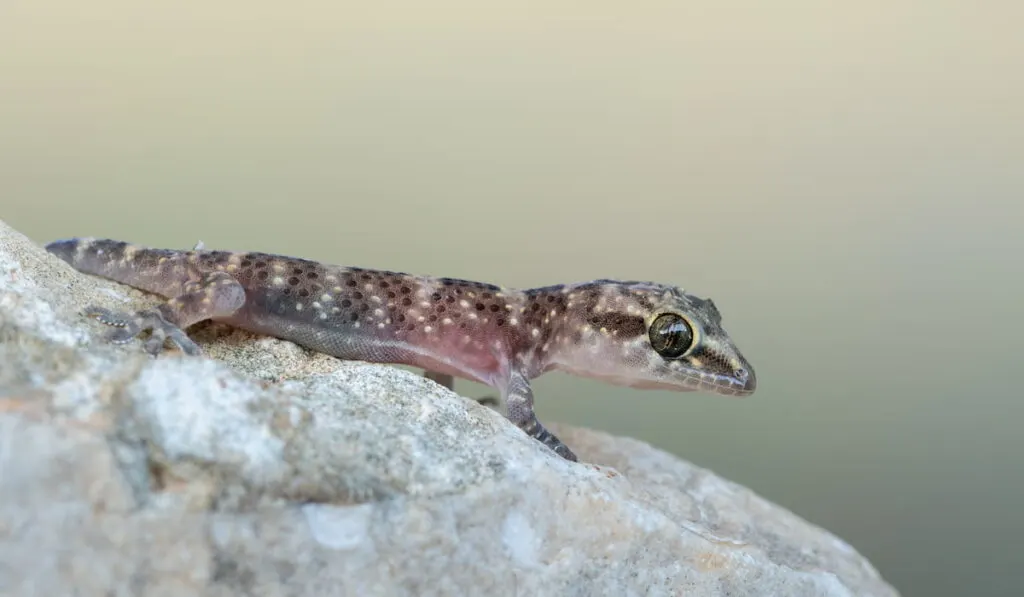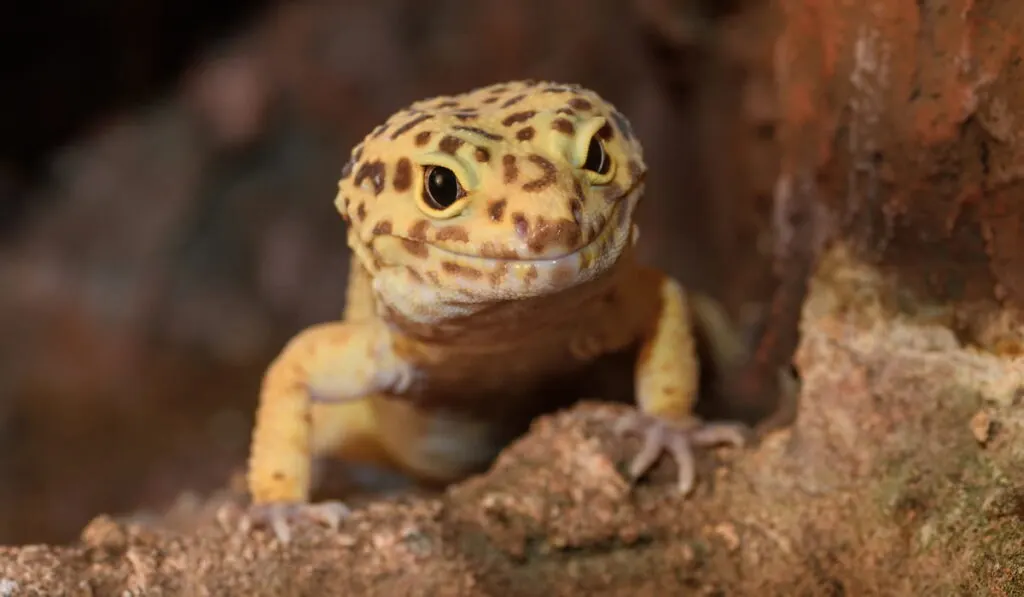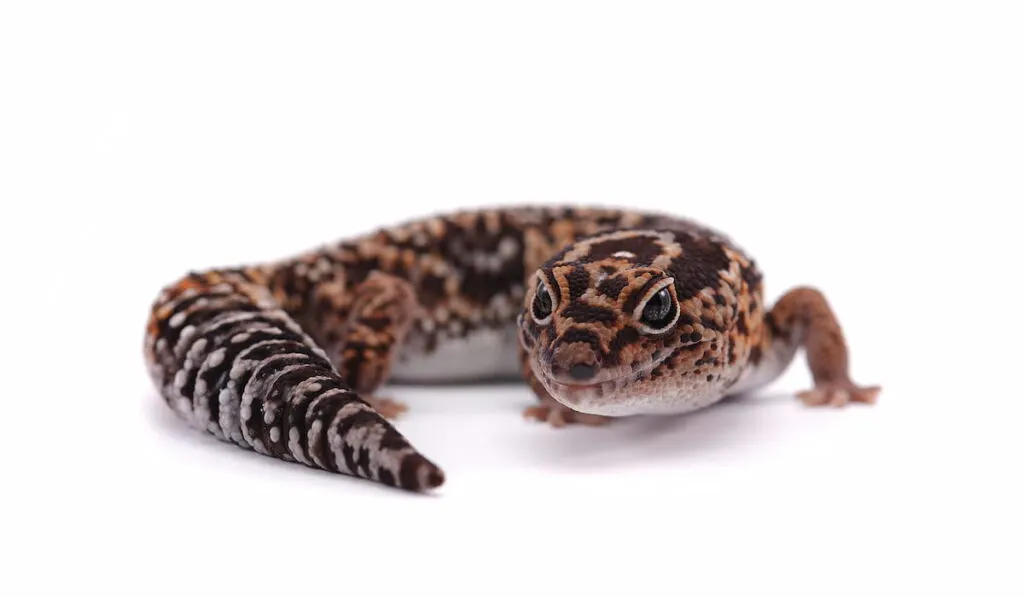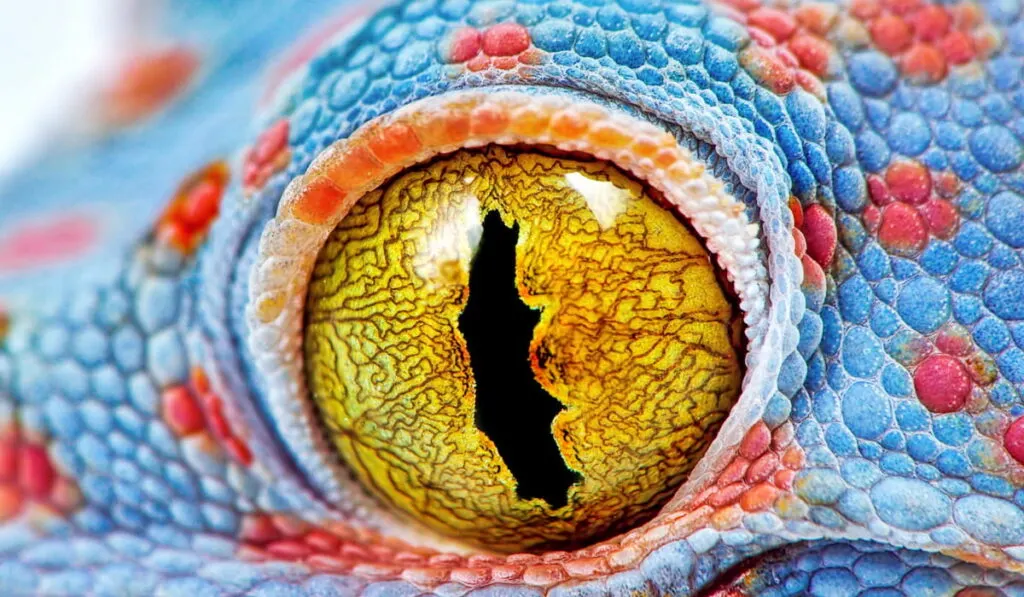Many varieties of geckos have the ability to change color. Geckos, much like chameleons, are unique with the ability to change the color of their skin.
Unlike chameleons, however, geckos change color based on their environment and surroundings. Surprisingly, they are able to do this without even looking at them.
For example, many geckos have a base color of yellow. But when they are placed into a brown environment, they may quickly turn a similar color, within 7-20 seconds.

Although this is true, geckos are not able to convert to all colors of the rainbow. They may assume colors commonly found in nature, but cannot change to just any color.
| Type of gecko | Why they change color | What color they change to? |
| House gecko | Avoid predators | Yellow, grey, green |
| Crested gecko | Blend into environment | Pale pink to deep brown |
| Leopard gecko | Shedding and birth | Varies |
| African fat-tailed gecko | Blend into environment | Varies |
| Tokay gecko | Based on mood | Dark blue or orange |
Note: All geckos, when shedding will create a thin layer of white skin, which can influence their skin color before and after shedding.

Table of Contents
Types of Geckos and Their Colors
It is not necessarily common to know which geckos have the ability to change color. This is a list of the most common kinds of geckos, the colors they can be, and why they change.
House Gecko
The house gecko is native to southeastern Asia. These geckos are commonly found across the world to this day and maybe bought in most pet stores and online.
A house gecko may change color in order to avoid predators as well as to blend in with their environment.
These color changes occur within the pigment-containing cells of the gecko’s skin. These cells expand or contract in a variety of ways which produces color changes. These colors may include yellow, grey, and green.
In addition, they do not camouflage based on what they see, but based on their sense of their surroundings.

Crested Gecko
The crested gecko is native to the French island territory of southern New Caledonia, in the Pacific Ocean.
These geckos were discovered in 1866 by a French zoologist and soon after were thought to be extinct due to the limited numbers found. They were rediscovered in 1994 during an expedition.
Crested geckos have pigments within their skin that have the ability to change color from a pale pinkish white to a deep dark brown and various colors in between.
This can be due to the desire to blend into the environment and can also be dependent on their mood.
Leopard Gecko
The leopard gecko is a very popular pet. These geckos originated in the dry, hot deserts of Afghanistan, Iraq, and today can be found across the world. They have been one of the most commonly kept reptiles as pets for years.

Leopard geckos are bred for a wide variety of colors and patterns called “morphs”. Each morph has different characteristics and can be quite beautiful.
While leopard geckos are not true color changers, they may change color shades slightly until they are about a year to a year and a half, when they reach full maturity.
Some of the colors they could be include, bright yellows, patterns with pale pinks and browns, white, black and white, and the very rare pure black.
Leopard geckos with spots can appear to have the most pronounced changes in appearance due to the changes in their spots as they shed their skins and grow.
African fat-tailed gecko
The African fat-tailed gecko is native to West Africa. These geckos are commonly found in dry desert environments and enjoy spending their time in dark and small spaces.
The African fat-tailed gecko may live to be 15-20 years old in captivity as a pet. The most common color is light brown to dark brown with hints of yellow and potentially white and black spots and stripes.
For the most part, African fat-tailed geckos do not change color, however, a few morphs can change in response to a new environment.
For example, a light brown gecko with little spots of yellow may turn a darker brown with darker yellow spots when feeling threatened or attempting to hide from predators.

Tokay Gecko
The Tokay gecko originated in Asia and more tropical islands. They enjoy warm, tropical, and humid areas with less light.
They can be good pets but are not as common as the ones listed above. Nevertheless, they can be found in some online reptile stores such as the one listed below.
The Tokay gecko is known for its vibrant color. Normally a bright blue color, they may also be a shade of orange. However, this can change through their lifespan and easily darken or brighten with mood.(source)
Do Baby Geckos Change Color?
Overall, geckos often change color drastically from the time they are hatchlings to when they are fully mature.
In some cases, depending on the type of gecko, and gender, these colors may become spotted or patterned and their array of colors may indicate what they will look like when fully mature.
Due to their young age and decreased levels of maturity, gecko varieties with the ability to change color may have a harder time blending into the environment or displaying their mood.
As geckos age, their color may grow brighter or become duller, or even change its pattern. Gecko colors vary depending on the type of gecko, but are commonly a shade of green, yellow, and brown.

Do Geckos Change Color as They Shed?
When shedding, a gecko’s color becomes very dull and they may even turn white just prior to releasing their skin layer. Once the shedding process is complete, geckos will regain their vibrant coloring.
During shedding, they will exhibit a lighter layer of white skin that is being sloughed off. The first signs of this are a duller, flatter color.
After the shedding process is done, the gecko may return to its original color and in some cases may become darker or lighter, depending on activity level, age, and sex.
Do Geckos Change Color as They Age?
A gecko’s color may change with age. Several gecko species will hatch with vibrant colors, whether it’s orange, yellow, green, or brown. When aging, this color drastically fades more and more as they reach maturity.
After about 12-16 months, a gecko will be the color that they will likely be for the rest of their lifespan. However, this may change subtly with time, health issues, lack of vitamins, or through shedding and diet.
Do a Gecko’s Eyes Change Colors?
A gecko’s eye color does not change, although their skin color may change drastically throughout its lifespan. The pigmentation in their eyes is set, unlike their skin color.
For instance, if a gecko is born with red eyes, this color will remain the same for its full life. There may be subtle changes over the years, however, depending on exposure to sunlight and health issues.

Important Note
This information is not suitable for being used as veterinary advice. If you believe there is something wrong with your gecko, it is vital to seek medical attention from a vet right away to ensure proper care and health.
Resources
- https://www.treehugger.com/surprising-facts-about-geckos-4864284
- https://www.definitions.net/definition/common%20house%20gecko
- https://www.dogonews.com/2009/10/22/geckos-nature-s-masters-of-disguise
- https://en.wikipedia.org/wiki/Crested_gecko
- http://www.moonvalleyreptiles.com/crested-geckos/morphs
- https://animals.sandiegozoo.org/animals/leopard-gecko
- https://www.lizards101.com/why-is-a-leopard-gecko-turning-brown/
- https://en.wikipedia.org/wiki/African_fat-tailed_gecko
- https://en.wikipedia.org/wiki/Tokay_gecko
- https://www.thesprucepets.com/tokay-geckos-1236913
- https://www.gargoylequeen.com/color-progression-how-gqr-geckos-color-up-as-they-grow.html
- https://oddlycutepets.com/leopard-gecko-pale/
- https://www.lizards101.com/why-is-my-crested-gecko-changing-colors/
- http://www.geckosunlimited.com/community/leopard-geckos-husbandry-housing-and-heating/78857-gecko-eye-color-change.html
